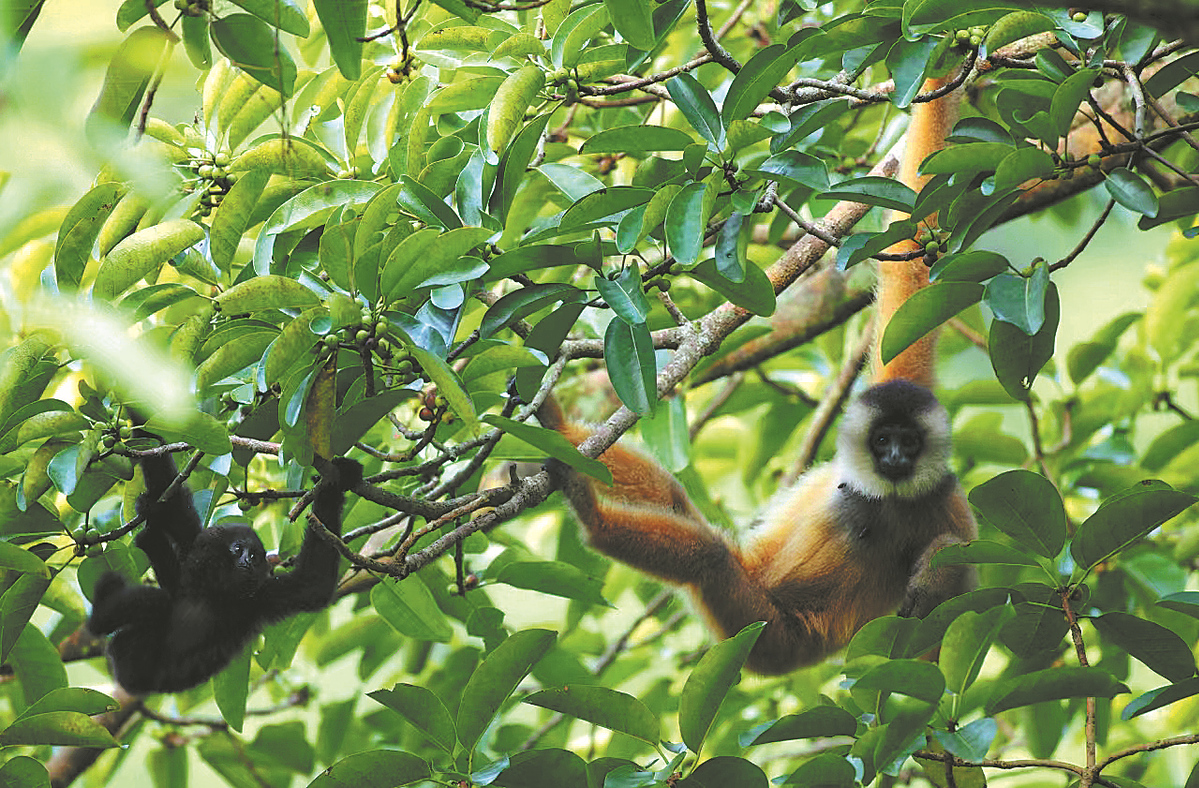
A female cao vit gibbon (right) and her baby are seen in the forest canopy in the Bangliang National Nature Reserve in Jingxi county, Guangxi Zhuang autonomous region. ZHAO CHAO/FOR CHINA DAILY
Living in a single patch of subtropical karst forest covering less than 50 square kilometers between China and Vietnam, the cao vit gibbon is the second-rarest primate in the world, only behind the Hainan gibbon, which has a wild population of 37 individuals in six groups.
The critically endangered species, also known as the eastern black-crested gibbon, has an estimated population size of around 120 individuals.
However, in a paper published on Jan 4 in Scientific Reports, an open-access journal publishing original research, scientists from China, Vietnam and the United Kingdom estimated that the wild population of the gibbon was even smaller, according to a 2021 survey.
"We estimate it was comprised of 74 individuals in 11 family groups," said Fan Pengfei, professor with Sun Yatsen University's Life Science College, who is one of the article's co-authors.
According to the researcher, whose team has been monitoring the gibbon's population within China for years, it doesn't mean that the population has declined. "In fact, the population appears to be growing, with new groups having formed in recent years," he said.
The recent result came from a revised method for monitoring gibbons.
Traditional methods, involving triangulation of groups from their songs, are relatively subjective and likely lead to measurement errors.
During the 2021 population survey, the scientists combined traditional observations made by survey teams with concurrent passive acoustic monitoring by recording devices, and assistance from an unmanned aerial vehicle with a mounted thermal camera.
"Through the method, we managed to use vocal fingerprinting to distinguish the different singing males in the population," Fan said.
Since the cao vit gibbon was rediscovered in 2002 in Vietnam and reconfirmed in China in 2006, Fan said, two protected areas have been established. One is the Cao Vit Gibbon Species and Habitat Conservation Area in Cao Bang province, Vietnam and another is the Bangliang National Nature Reserve in Jingxi county, Guangxi Zhuang autonomous region.
Other conservation measures include regular patrols by rangers and community groups; habitat restoration; support for sustainable livelihoods; awareness-raising about the plight of the gibbon; and educational events with local schools. Alongside these activities, periodic surveys of the wild population have been done.
However, for a long time, surveyors have been aware of substantial subjectivity inherent in population survey methods for gibbons. Most gibbon surveys have estimated density or abundance by triangulating group locations from multiple survey posts that are monitored simultaneously. "Gibbons are sometimes watched directly but, most often, are detected indirectly from their songs," Fan said.
If two groups sing close together at different times, he said, there is a risk that they are identified as one group and the total population size is underestimated. If a single group moves quickly to a new location and sings again, or moves a far distance between survey days, there is a risk that the group is identified as two groups, and the total population size is overestimated.
"We had long been thinking to revise the method," Fan said.
A key characteristic of a family of gibbons is their singing behavior. Like in other gibbon species, cao vit gibbons in family groups sing during most mornings. Community monitoring teams in Vietnam, as well as Fan's team in China, have often reported that individual gibbon groups have distinctive songs.
"The cao vit gibbon has shown that songs, in particular the male songs, are highly individualistic and stable over time," Fan said.
This discovery has led to the suggestion that these vocal "fingerprints" in gibbons could serve as the foundation for an objective population survey method.
At first, the scientists built a total of 29 listening posts distributed across the global range of the cao vit gibbon, 23 in Vietnam, four in China and two along the border. Listening posts were placed on mountain tops and ridges to maximize the probability of hearing and observing groups.
The surveyors monitored each listening post for at least five consecutive mornings, which was deemed to be sufficient to detect all groups.
A roving team also assisted in the counting of group sizes using a UAV. This team operated independently of the main survey teams, each morning selecting a listening post that might offer the best chance of detecting gibbon groups. Videos from the UAV were reviewed carefully and group size and composition counted.
Then the surveyors deployed acoustic recorders at 55 locations across the global range of the gibbon. The devices were programmed to record continuously every day.
Between Oct 26 and Nov 10, 2021, monitoring at the 29 listening posts across Vietnam and China generated 245 records of gibbons from field teams. The passive survey by acoustic recorders harvested more than 25,000 hours of sound clips.
"With the revised method, incorporating vocal fingerprinting and UAV-based group counts, we carried out the most robust survey so far of the last remaining cao vit gibbon population," Fan said.
Three of the 11 groups primarily reside in China and eight in Vietnam, according to the article.
"Group sizes observed during the survey were consistent with those from long-term monitoring in our country, with most groups consisting of one adult male, two adult females and dependent offspring," Fan said. "As we know it, this approach has never been employed in a gibbon species population survey before."
The paper emphasizes the urgent need for ongoing habitat restoration efforts, which are likely the most viable means of increasing population size. The cao vit gibbon is evidently facing immediate threats due to the effects of small population size, including the loss of genetic diversity, inbreeding and vulnerability to unforeseen catastrophes.





